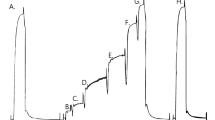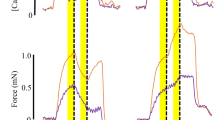Abstract
Single fibres of three different types, which had been characterized histochemically with regard to differences in myofibrillar adenosine triphosphatase (ATPase) activity and its pH stability, were microdissected from freeze dried preparations of the closer muscle in walking legs of the crab Eriphia spinifrons. Shortening velocities were determined in slack tests and under constant load conditions in maximally Ca2+-activated skinned muscle fibres. Force/pCa relationships were also measured for the different types of fibres. Compared with data on vertebrate muscles, all crab muscle fibres required large length changes to reach zero force and showed low Ca2+ sensitivity for isometric force generation. The length/time relationship obtained from slack tests had a biphasic course. Maximal velocity of filament sliding differed in the three types of fibres investigated. The filament sliding of type IV fibres was about 3 times faster than that of type I fibres. The values obtained for type II fibres ranged in between. These data are positively correlated with myofibrillar ATPase activity determined histochemically. Ca2+ sensitivity of force generation was lowest in the fast type IV fibres. It was high in the slow type I and the faster contracting type II fibres. Ca2+ sensitivity in crab muscle seems not to be correlated with speed of shortening.
Similar content being viewed by others
References
Altringham JD, Johnston IA (1982) The pCa-force and force-velocity characteristics of skinned fibres isolated from fish fast and slow muscles. J Physiol (Lond) 333:159–176
Atwood HL, Hoyle G, Smyth T (1965) Mechanical and electrical responses of single innervated crab-muscle fibres. J Physiol (Lond) 180:449–482
Barany M (1967) ATPase activity of myosin correlated with speed of muscle shortening. J Gen Physiol 50:197–216
Costello WJ, Govind CK (1983) Contractile responses of single fibers in lobster claw closer muscle. Correlation with structure, histochemistry, and innervation. J Exp Zool 227:381–393
Edman KAP (1979) The velocity of onloaded shortening and its relation to sarcomere length and isometric force in vertebrate muscle fibres. J Physiol (Lond) 291:143–159
Edman KAP, Reggiani C, Schiaffino S, te Kronnie G (1988) Maximum velocity of shortening related to myosin isoform composition in frog skeletal muscle fibres. J Physiol (Lond) 395:679–694
Eisenberg E, Hill TL, Chen Y (1980) Cross-bridge model of muscle contraction. Quantitative analysis. Biophys J 29:195–227
Galler S, Rathmayer W (1988) Measurements of contraction-velocity in identified skinned muscle fibers of a crab. Pflügers Arch [Suppl] 411:R191
Galler S, Hutzler C, Haller T (1990) Effects of taurine on Ca2+-dependent force development of skinned muscle fibre preparations. J Exp Biol 152:255–264
Govind CK, Budd TW, Atwood HL (1981) Fiber composition and innervation patterns of the limb closer muscle in the lobster Homarus americanus. Biol Bull 160:69–79
Hatcher DD, Luff AR (1985) Force-velocity properties of fast-twitch and slow-twitch muscles of the kitten. J Physiol (Lond) 467:377–385
Jahromi SS, Atwood HL (1971) Structural and contractile properties of lobster leg-muscle fibers. J Exp Zool 176:475–486
Lännergren J, Smith RS (1966) Types of muscle fibres in toad skeletal muscle. Acta Physiol Scand 68:263–274
Lännergren J, Hoh JFY (1984) Myosin isoenzymes in single muscle fibres of Xenopus laevis: analysis of five different functional types. Proc R Soc Lond [Biol] 222:401–408
Maier L, Rathmayer W, Pette D (1984) pH lability of myosin ATPase permits discrimination of different muscle fiber types in crustaceans. Histochemistry 81:75–77
Maier L, Pette D, Rathmayer W (1986) Enzyme activities in single electrophysiologically identified crab muscle fibers. J Physiol (Lond) 371:191–199
Moisescu DG, Thieleczek R (1978) Calcium and strontium concentration changes within skinned muscle preparations following a change in the external bathing solution. J Physiol (Lond) 275:241–262
Moore G, Johnston IA, Goldspink G (1983) The pCa-tension characteristics of single skinned fibres isolated from the anterior and posterior latissimus dorsi muscles of the chicken. J Exp Biol 105:411–416
Moss RL (1986) Effects of shortening velocity of the rabbit skeletal muscle due to variations in the level of thin filament activation. J Physiol (Lond) 377:487–505
Ogonowski MM, Lang F (1979) Histochemical evidence for enzyme differences in crustacean fast and slow muscle. J Exp Zool 207:143–151
Potter JD, Johnson JD (1982) Troponin. In: Cheung W (ed) Calcium and cell function (vol 2). Academic Press, New York, pp 145–173
Rathmayer W, Erxleben C (1984) Identified muscle fibers in a crab. I. Characteristics of excitatory neuromuscular transmission. J Comp Physiol 152:411–420
Rathmayer W, Maier L (1987) Muscle fiber types in crabs: studies on single identified muscle fibers. Am Zool 27:1067–1077
Reiser PJ, Moss RL, Giulian GG, Graeser ML (1985) Shortening velocity in single fibers from adult rabbit soleus muscles is correlated with myosin heavy chain composition. J Biol Chem 260:9077–9080
Staron RS, Pette D (1986) Correlation between myofibrillar ATPase activity and myosin heavy chain composition in rabbit muscle fibers. Histochemistry 86:19–23
Stephenson DG, Williams DA (1981) Calcium-activated force responses in fast- and slow-twitch skinned muscle fibres of the rat at different temperatures. J Physiol (Lond) 317:281–302
Trueblood CE, Walsh TP, Weber A (1982) Is the steric model of tropomyosin action valid? In: Twarog BM, Levine RJC, Dewey MM (eds) Basic biology of muscles: a comparative approach. Raven, New York, pp 223–241
Tse FW, Govind CK, Atwood HL (1981) Diverse fiber composition of swimming muscles in the blue crab, Callinectes sapidus. Can J Zool 61:52–59
Wiens TJ, Maier L, Rathmayer W (1988) The distribution of the common inhibitory neuron in brachyuran limb musculature. II. Target fibers. J Comp Physiol 163:651–664
Wnuk W, Schoechlin M, Stein EA (1984) Regulation of actomyosin ATPase by a single calcium-binding site on troponin C from crayfish. J Biol Chem 259:9017–9023
Woledge RC, Curtin NA, Homsher E (1985) Energetic aspects of muscle contraction. Academic Press, London
Zite-Ferency F, Rüdel R (1978) A diffractometer using a lateral effect photodiode for the rapid determination of sarcomere length changes in cross-striated muscle. Pflügers Arch 374:97–100
Author information
Authors and Affiliations
Rights and permissions
About this article
Cite this article
Galler, S., Rathmayer, W. Shortening velocity and force/pCa relationship in skinned crab muscle fibres of different types. Pflügers Arch. 420, 187–193 (1992). https://doi.org/10.1007/BF00374989
Received:
Revised:
Accepted:
Issue Date:
DOI: https://doi.org/10.1007/BF00374989




